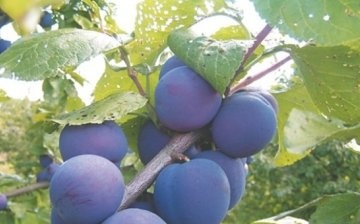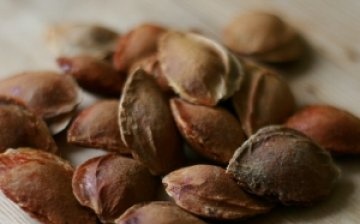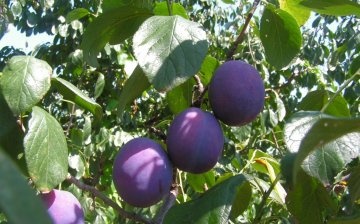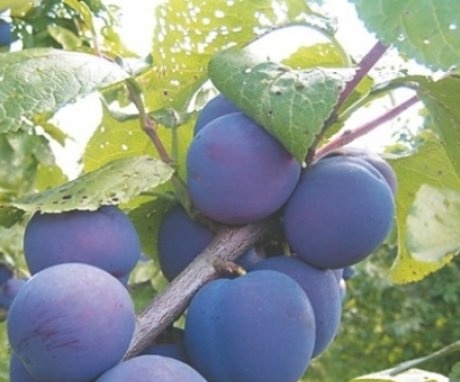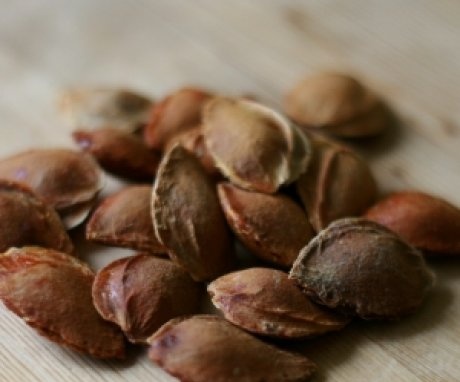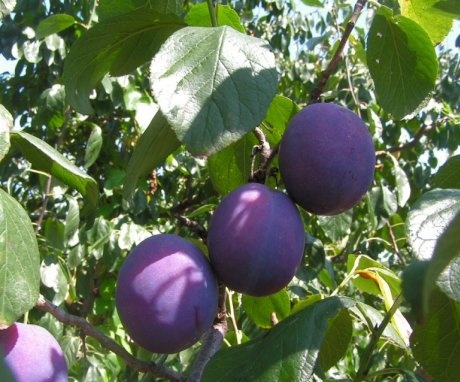Plum Renklode Soviet: description, cultivation and care
The word "renclode" has French roots and means a high quality plum variety. Their fruits are large, juicy and rather sweet.
Content:
General information about the variety
There are several types of renklodes. Plum Renklode Soviet, which will be discussed, is popular for its incredible frost resistance. It survives even with a very strong minus, which is a constant plus for our climate. For this reason, gardeners are very fond of this plum.
Plum characteristic:
- Fruits are round, rather large with a beautiful dark purple skin color.
- The pulp is yellow, juicy, can be loose, if the plum is overripe, easily leaves the stone. The taste is sweet with a slight sourness.
- The trees are not tall and do not have dense foliage. They bloom with small white flowers.
The home plum is believed to have Persian roots. This plant does not grow wild, although we often see trees outside of garden plots. They grew up without human participation, but still these cases are isolated.
Renklode Sovetsky is also famous for its high yield.
But there are also some disadvantages. Among them is the excessive softness of ripe fruits. Fans of compotes will understand this disadvantage. When boiled, the fruits turn into gruel. But fresh plums are perfect for consumption. They are not cloying, but also not sour, rich in vitamins and minerals, and also help with constipation.
However, due to the laxative effect, they must be given with caution to young children. You can also squeeze juice with pulp from the plums and preserve, make jams. You can also use the leaves for decoctions. When taken orally, such a medicine has a beneficial effect on blood vessels, reduces thrombus formation.
How to grow a Soviet Renklode plum?
Of course, the easiest way is to buy a ready-made seedling in a specialized store or order on the website. But a renklod can be grown from a bone. For this:
- Select ripe (but not overripe) fruits, carefully separate the pulp from the stone. In a reklod, this is done easily if the fruit has reached the desired degree of ripeness.
- Next, the bones need to be washed and soaked in water. Regularly, you need to change the water to clean, and mix the bones. If the water is allowed to stand for a long time, bacteria and microorganisms can grow in it. Thus, we soak the bones for 4 days.
- Then we put them on a dry surface and dry thoroughly. These seeds can be stored long enough until the moment when you need to plant them.
- Before planting seeds and waiting for shoots (about six months before planting), mix them with slightly damp sand or sawdust and leave that way until planting. You can sow seeds directly into open ground. This is done either in the fall or towards the end of spring, when there are no frosts at night.
- Thoroughly choose a place for a seedling... The soil should not be acidic, and there should be a lot of light. The shade negatively affects the quality of the fruit and the density of the crown. Make sure that nothing obscures the seedling: trees, fences, building.
- If you are planting several plums, the distance between the trees should be at least 3 m. This will ensure calm growth for the roots and sufficient sunlight for the crown.
At the same time, a completely open place may not be the best option, since young seedlings do not tolerate strong winds well. For the first time, you can make a greenhouse.
The landing hole should be deep enough, about half a meter.
Together with the seedling, stick a peg into the hole, to which you will then tie a tree (necessarily from the north side). When planting, cover the roots with soil without fertilization.
Care features
Secrets of tree care:
- Be sure to loosen the soil before watering so that a crust does not form, preventing water from reaching the roots. This will ensure that the roots receive sufficient oxygen and water.
- Remove all weeds from the trunk circle, as well as within a radius of 3 m, including the roots, if possible.
- Renclode loves fertilizers, but they need to be applied correctly and at the right time. So, during a period of rapid growth, it is necessary to feed the plum with nitrogen fertilizers, and in winter, organic fertilizers will come in handy.
- Daughter shoots may appear next to the mother tree, which must be removed. It draws nutrients from the roots of the main tree, which will negatively affect fruiting.
- Renklode tends to bear fruit unevenly. One season the harvest will be plentiful, the other poor. To avoid this, thin out green fruits before they ripen. It is good if the fruits are at such a distance that they do not touch each other. This will help the tree retain some of the nutrients until the next fruiting.
- Be sure to remove damaged fruits from the tree. Tear off the plum at the first sign of decay.
If you are thinning the fruit, but you see that the branches are still hard, prop up the heaviest branches with sticks. Wrap a cloth around where the support touches the bark to avoid damaging the branches.
The tree needs to be pruned into the desired shape.
This is best done in the spring, before the leaves bloom, but after the night frosts have ended. Always prune branches with a sharp knife and very neat. You can process the cut site with garden pitch. Observing the basic rules of care, you can get an excellent harvest in a short time and be convinced of the benefits of the variety.
More information on how to trim plums can be found in the video.




